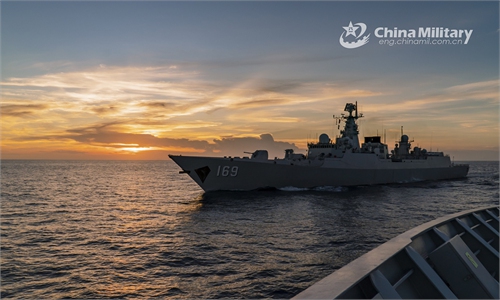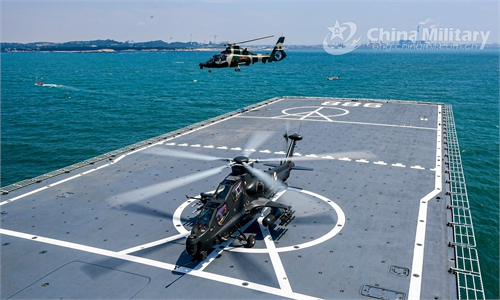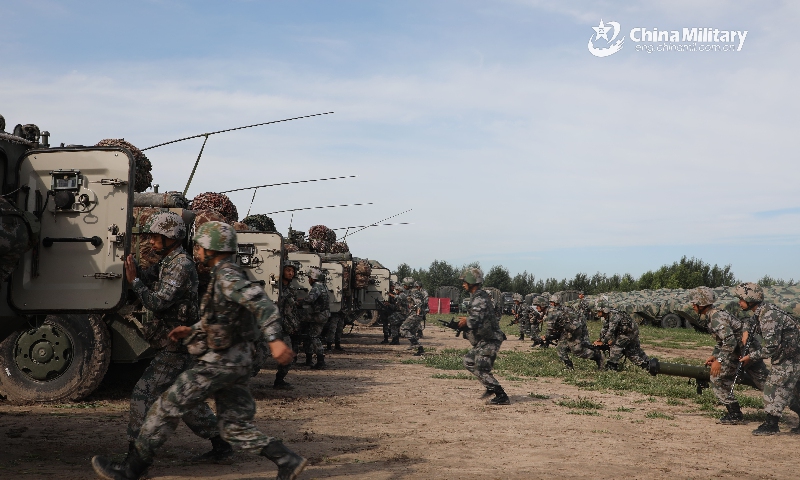
Infantrymen assigned to a combined arms brigade under the PLA 78th Group Army rush to board infantry fighting vehicles during a tactical training exercise in early August, 2020. (eng.chinamil.com.cn/Photo by Feng Cheng)
The Chinese People's Liberation Army (PLA) has been holding consecutive, concentrated military drills in all four major Chinese sea regions since mid-August, which is seen as a direct and strong response to the recent negative moves by Taiwan secessionists and the US, but the US military has not restrained its provocations and even bolstered its military operations around the island of Taiwan.
These US operations should not be interpreted only as a pure strategic card aimed at provoking and pressuring the Chinese mainland, they also exposed some practical and tactical arrangements of how the US plans to intervene in a possible military conflict between the Chinese mainland and the island of Taiwan, Chinese mainland experts said on Monday.
The recent US military activities, when put together, have revealed a series of interconnected missions that bring new threats to a potential reunification-by-force operation by the PLA, they pointed out, noting that the PLA can thwart any foreign intervention and stands ready against these challenges should they arise.
With the PLA acting as a deterrent, the possibility of a US military intervention remains low, analysts said.
On August 17, two US Air Force B-1B bombers took off from Guam and returned to South Dakota. But one of them, instead of flying the shortest return route, flew near the island of Taiwan and into the East China Sea first before leaving, media reported at that time.
Wei Dongxu, a Beijing-based military expert, told the Global Times on Monday that the US bomber intentionally flew a longer route to practice its aerial assault and long-range precision attack capabilities. Equipped with cruise missiles, the B-1B can launch attacks from sea on targets deep in land or on warships.
Taking off from Guam, US bombers can play a leading assault role to intervene in the situation in Taiwan, analysts said.
The B-1B bombers were not acting alone. Days before their mission, from August 13 to 15, the US military conducted at least seven sorties with multiple types of reconnaissance aircraft, including P-8A and P-3C maritime patrol aircraft and RC-135 and EP-3E reconnaissance aircraft, according to the Beijing-based think tank South China Sea Strategic Situation Probing Initiative (SCSPI) on August 15.
Additionally, the US also deployed B-2 bombers to Diego Garcia in the Indian Ocean, which conducted joint tactical training on August 18, US military newspaper Stars and Stripes reported on Wednesday.
US reconnaissance aircraft sorties near the Chinese mainland and Taiwan island have become increasingly frequent since June, and experts said their mission is likely gathering intelligence on PLA movements, including those on warships, submarines, troop deployments and ballistic missiles.
Combining these activities together, Wei said that the US can use such intelligence gathered by its reconnaissance aircraft in guiding its bombers into attack. "The reconnaissance aircraft are its eyes, and the bombers are its punches," he said.
Chinese mainland military expert and TV commentator Song Zhongping told the Global Times on Monday that the US could use its bases in Guam in the West Pacific and Diego Garcia in the Indian Ocean to host bombers for long-range strike missions on the PLA without entering the PLA's air defense zone.
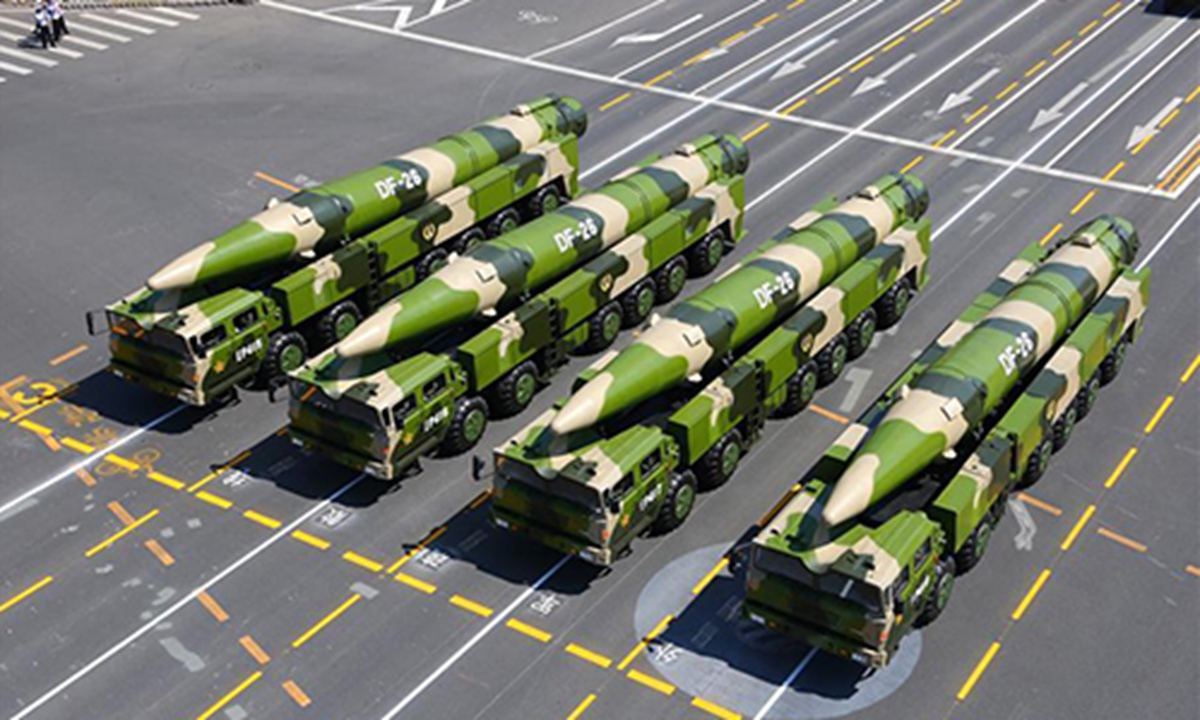
File photo taken on Sept. 3, 2015 shows DF-26 missiles attending a military parade in Beijing, capital of China. It has been a big year for China's military as the People's Liberation Army (PLA) is to celebrate its 90th birthday. As Aug. 1, the birthday of the PLA, approaches, the country's army has shown how much its military capacity has grown and how committed it is to maintaining world peace. The PLA has come a long way since its birth during the armed uprising in the city of Nanchang on August 1, 1927, when it had only 20,000 soldiers. Ninety years later, the country boasts 2 million servicemen, according to a national defense white paper titled "China's Military Strategy," published in 2015. Besides the growth in numbers, the PLA has armed its soldiers with world-class equipment. As of June 2017, the Chinese military had participated in 24 UN peacekeeping missions, sending 31,000 personnel, 13 of whom lost their lives in duty. Since 2008, the Navy has dispatched 26 escort task force groups, including more than 70 ships for escort missions in the Gulf of Aden and off the coast of Somalia. More than 6,300 Chinese and foreign ships have been protected during these missions. Photo: Xinhua
Some of the PLA weapons that the US feared most are the DF-21D and DF-26 anti-ship ballistic missiles, which pose a significant threat to large and medium-sized vessels like aircraft carriers. By detecting their positions with specially designed RC-135 aircraft and destroying them with B-1B bombers, the US is hoping to minimize this huge threat, a Chinese mainland military expert told the Global Times on Monday under the condition of anonymity.
With US warships safer from PLA attacks, they can approach closer and become capable of attack, the expert said.
US warships have also been training near the Chinese mainland and Taiwan island. Since the deployment of the USS Ronald Reagan aircraft carrier in the West Pacific in June, it continuously held exercises in the Philippine Sea, South China Sea and East China Sea, occasionally with the USS Nimitz carrier, and sometimes with Japanese and Australian warships in joint drills, SCSPI said.
The USS Mustin destroyer sailed through the Taiwan Straits on August 18, a move analysts said could also be an attempt to gather the latest hydrologic information and PLA deployment intelligence.
Song also warned of US military activities not known to the general public. The US' nuclear-powered attack submarines can use cruise missiles to stealthily attack land bases, ports and airfields, and use torpedoes and anti-ship missiles to attack warships, Song said.
In the event that the Chinese mainland decides to reunify Taiwan by force, and if the US manages to put these tactics into practice, in a worst-case scenario for the PLA, the US could possibly slow down the PLA's landing and create strategic opportunities for more reinforcements, observers said.
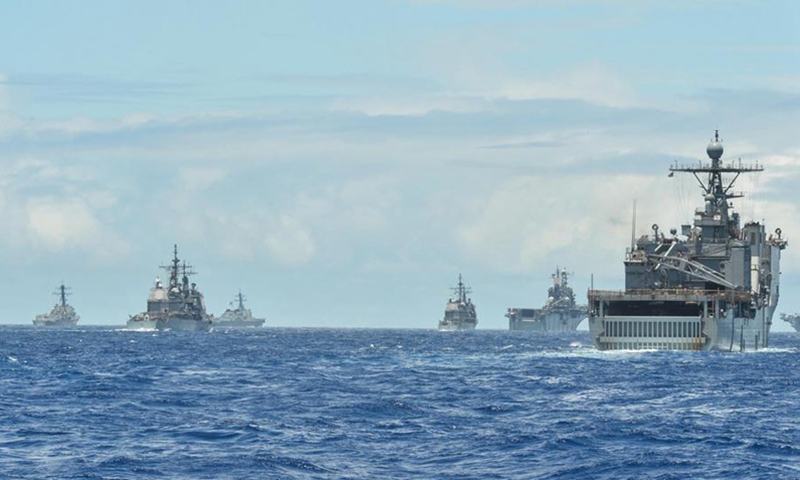
42 naval vessels that participated in Rim of the Pacific (RIMPAC) multinational naval exercises conduct drills near Hawaii, July 25, 2014. Photo: Xinhua
PLA fully prepared
While the US military will unlikely engage the Chinese mainland in a military conflict around the time of its presidential election, the PLA needs to be fully prepared for such a scenario, because the US is indeed attempting to use a military approach to contain the Chinese mainland in resolving the Taiwan question, Song said.
If a war breaks out in the Taiwan Straits, the PLA is capable of acting fast and leaving no time for the US to come to the secessionists' aid and rescue, the anonymous expert said, noting that the mobilization of forces from the US mainland usually takes more than one week, and US bases in the Asia-Pacific region are all reachable by PLA missiles including the DF-17 and DF-26.
Two PLA aircraft carriers, the Liaoning and Shandong, could be deployed east to the island of Taiwan to cut off easy access of US forces to the region, mainland military observers said.
The key roles in the exposed US tactics - the bombers that can knock out PLA warships, bases and missiles - will also not succeed in their missions, because they, together with missiles they could have launched, would be intercepted by PLA air defense forces, experts said.
"If the US has this kind of military intention, the PLA should take active defense strategies. This includes enhancing comprehensive defensive capabilities by boosting air defense installations around key military facilities in coastal regions and islands, and using DF series ballistic missiles as tactical and strategic counterattack measures to balance the US' aggressive forces, so the US will need to think twice before acting," Wei said.

